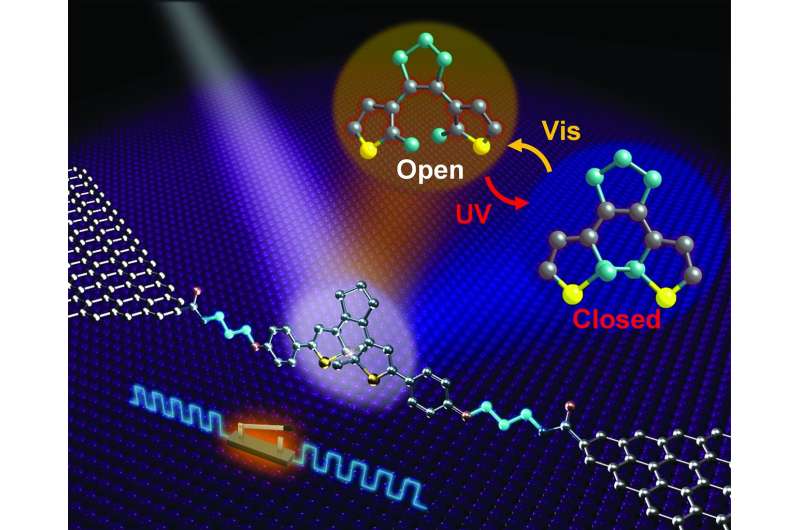June 21, 2016 report
A photoswitch made using just one photosensitive molecule

(Phys.org)—A team of researchers with members from institutions in China and the U.S. has successfully created a photoswitch from a single photosensitive molecule. In their paper published in the journal Science, the team describes the changes they made to earlier versions of the switch that allowed it to operate successfully for an entire year.
As scientists seek to make ever faster computers, they have sought ways to make them smaller—the smaller the parts, the less distance information in such a machine must travel. They have also increasingly turned to using light to carry information, rather than electricity, because it travels so much faster. To that end, several teams have attempted to create single molecule switches that can be turned on and off by exposure to light. Until now, such attempts have not worked well (switches have often become stuck), and those that showed promise lasted for just hours, days or weeks. In this new effort the researchers report that they have improved a prior technique by fixing a sticking problem and have not only fixed the problem, but have created a switch that was able to operate for over a year.
One of the prior attempts to use a single photosensitive molecule resulted in failures due to the molecule becoming stuck in a single state (open, allows for electrical conduction, closed, makes it an insulator). The problem, the team with this new effort found, was unwanted interactions occurring between the electrode and the molecule. To fix this problem, they placed three methylene groups between a graphene electrode and the molecule, preventing the interactions from occurring. This resulted in a photoswitch that could be turned "on" by exposure to normal light, and "off" by exposing it to UV light.
The team made 46 such switches, all of which, they report, worked as hoped, dutifully turning on and off on demand. All of the devices were run successfully for over a year. The team is now in the process of looking closer at their switches to learn more about their quantum properties and plan to look into whether it might be possible to combine such switches to create multi-level switching devices.
More information: C. Jia et al. Covalently bonded single-molecule junctions with stable and reversible photoswitched conductivity, Science (2016). DOI: 10.1126/science.aaf6298
Abstract
Through molecular engineering, single diarylethenes were covalently sandwiched between graphene electrodes to form stable molecular conduction junctions. Our experimental and theoretical studies of these junctions consistently show and interpret reversible conductance photoswitching at room temperature and stochastic switching between different conductive states at low temperature at a single-molecule level. We demonstrate a fully reversible, two-mode, single-molecule electrical switch with unprecedented levels of accuracy (on/off ratio of ~100), stability (over a year), and reproducibility (46 devices with more than 100 cycles for photoswitching and ~105 to 106 cycles for stochastic switching).
Journal information: Science
© 2016 Phys.org





















